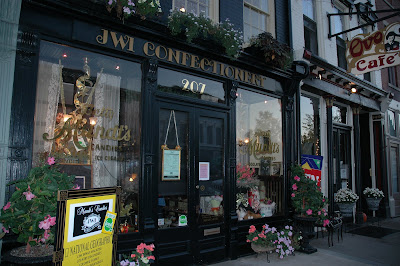
Whenever I visit Madison, which is never as often as I would like, I start off by buying a latte at one of the charming shops downtown and then ambling through this historic river port. No matter how many times I’ve been here, I always find something new – or something old that I’ve never seen before.
Settled on the north banks of the slow moving Ohio River, Madison, in the rolling hills of Southern Indiana, has the largest historic district in the state with more than 133 blocks on the National Register of Historic Places. But historic preservation buffs can do more than just stroll through the downtown with its fine examples of Second Empire, Classical Revival and Italianate architecture and in residential neighborhoods whose early Federal style buildings seem more akin to Alexandria, Virginia than Southern Indiana. That’s because Madison has several unique homes and businesses, now open to the public, whose interiors have remained intact since their doors closed, some almost a century ago.
When Dr. William Davies Hutchings died in 1903, his daughters turned the key on this early Greek Revival building. Inside the office, sealed for almost 70 years, were all his belongings and medical instruments. Now the property of Historic Madison Inc. (HMI), a not for profit historical preservation organization, Dr. Hutchings office as it was 104 years ago gives a glimpse of the practice of a horse and buggy physician.

“You’ll see a number of these places in Madison,” says John Staicer, executive director of HMI. “It’s as if they were frozen in time from the day they closed to when they were reopened.”
According to Staicer, another example of this preserved in amber aspect of the city is the Ben Schroeder Saddletree Company, also operated by HMI. The business manufactured wooden frames for saddle makers from 1878 to 1972, outfitting the troops (or at least their horses) in every American war that occurred during those years.
“They just shut the doors, leaving all the original equipment in the factory,” Staicer says noting that there was very little modernization over the years. “The earliest documented piece of machinery there dates to 1882. It’s like the workers left one day and just never came back.”
The first time Maryanne Imes unlocked Mundt’s Candies in downtown Madison, 30 years after the store, which opened at this location in 1917, went out of business, she remembers a feeling of awe as well as an overwhelming smell of mustiness.
“My mother used to take me there to buy candy when I was a girl,” says Imes who restored the 1835 Federal style building, preserving the glass and wood display cases which date back to the turn of the last century and the hand pulled elevator that takes workers and goods to the third floor kitchen. It is in this kitchen that Imes and her staff, using antique wooden molds, make the colorful fish candies that have been popular in Madison since the mid 1800s. Downstairs, shelves and cases are stuffed with candies and the old fashioned soda fountain is once again dispensing malts and ice cream sundaes.

For years, Madison was a popular steamboat stop and today it’s still possible to see ornate riverboats make their way along the Ohio River. The movie “Madison” is based upon the annual regatta which started in Madison back in 1914. The city’s Riverfront Park offers views of the bridge which crosses over into Kentucky, boat launching facilities and is where many of the city’s annual festivals including Barbeque Blues & Balloons and Ohio River Valley Folk Festival, are held.

Follow the walking path along the river west to the apricot colored Lanier Mansion, built in 1844 and considered one of the finest examples of Greek Revival architecture in the country. The home, with its formal gardens stretching down towards the river’s edge, is now a house museum and features a myriad of distinctive details including a spiral stairway that tightly curls upwards like the interior of a seashell, an octangular cupola and oculus windows.

During the financial panic of 1837, J.D. Lanier, bank president, loaded $80,000 on a horse and some mules and rode to Washington D.C. to prove the financial stability of his Madison State Bank. It worked becoming one of the few in the west to stay open.
Just blocks from the river, downtown Madison is a charming collection of colorfully painted storefronts housing restaurants (try that southern specialty pimento cheese sandwiches at The Attic/Coffee Mill Café), antique shops and small town businesses that haven’t, unlike many cities, been shuttered by encroaching malls.

Gardens are important in Madison, so be sure to take a peek through the many decorative wrought iron fences (the city used to have several iron mongers) and around corners to see the profusion of blooms and garden art that abound. Grab a latte and a newspaper at Madison Coffee and Tea and stroll to the Broadway Fountain, a whimsical bronze piece with three basins of flowing waters. The fountain was first exhibited at the Centennial Exhibition in Philadelphia in 1876 and then purchased ten years later and moved to Madison.
Need to walk off the candy and pimento cheese sandwiches? Just a mile away is the awe inspiring Clifty Falls State Park with its limestone bluffs, fantastic river overlooks, canyons, creeks and seven waterfalls. Or hit the trail at Shilo Farms in nearby Canaan, where horses are available for trail riding.
For more information, call Madison Area Convention and Visitors Bureau at 800-559-2956or www.visitmadison.org.
Events to check out:
Madison Regatta
812-265-50000 or www.madisonregatta.com
July 4th weekend
Madison Ribberfest
800-559-2956 or www.madisonribberfest.com
Third weekend in August (Friday and Saturday)
Madison Chautauqua Festival of Art
800-559-2956 or www.madisonchautauqua.com
Last full weekend in September
--Jane Ammeson


